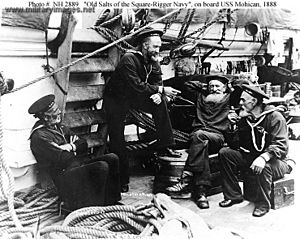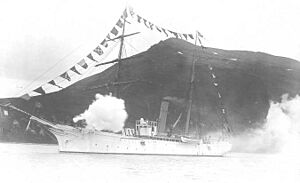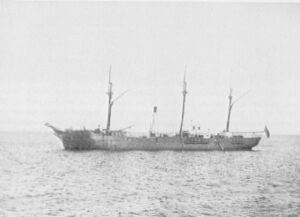Bering Sea Anti-Poaching Operations facts for kids
Quick facts for kids Bering Sea Anti-Poaching Operations |
|||||||
|---|---|---|---|---|---|---|---|
 "Old Salts of the Square-Rigger Navy" on board USS Mohican, 1888, by H. W. Whitaker. |
|||||||
|
|||||||
| Belligerents | |||||||
|
Canadian Poachers | ||||||
| Commanders and leaders | |||||||
| N/A | |||||||
| Strength | |||||||
| 1 cruiser 3 sloops-of-war 3 steamers 2 gunboats 2 cutters |
N/A | ||||||
| Casualties and losses | |||||||
| None | 4 schooners captured Poachers imprisoned in Unalaska |
||||||
In 1891, the United States and the United Kingdom worked together to stop illegal hunting in the Bering Sea. This area is part of the Pacific Ocean. The main goal was to protect the many seals living there. Their numbers were dropping very fast because of too much hunting.
Both governments sent a group of warships to the Bering Sea. This group was called a squadron. Their job was to stop people from illegally hunting seals. United States Navy Commander Charles S. Cotton led this important mission.
Contents
Protecting Seals in the Bering Sea
The problem of seal hunting started in the 1880s. At that time, Canada and the United States disagreed about who owned the fishing rights around the Aleutian Islands. The U.S. Navy even stopped some Canadian ships.
More importantly, seals were almost disappearing. This was because hunters from both Canada and the United States were catching too many. People who cared about nature asked their governments to help.
In 1891, President Benjamin Harrison and the British government made a new rule. They banned all seal hunting in the Bering Sea. They also decided to create a special naval squadron.
The Ships and Their Crews
Commander Charles S. Cotton led this new force. The squadron had small warships. Their job was to patrol the area and tell all ships about the new hunting ban.
Eleven ships took part in these operations. They were from the United States Navy, the Royal Navy, and the United States Revenue Cutter Service. The main ship of the American squadron was USS Mohican. It was a type of warship called a screw sloop.
Other American ships included USS Marion, USS Thetis, USS Alert, USS Ranger, USRC Corwin, and USCR Rush. The Al-Ki, a ship from a private company, was also used. It carried marines and was led by Captain Henry C. Cochrane. The Al-Ki was even used as a prison ship for captured hunters in Unalaska.
Most American ships had groups of marines on board. In total, there were five officers and 113 enlisted marines. The British ships also joined the effort. They included the cruiser HMS Porpoise, HMS Nymphe, and HMS Pheasant. Each of these British ships also had Royal Marines on board.
What the Squadron Did
The operations officially began on June 22, 1891. The Al-Ki left the Mare Island Naval Shipyard and headed for the Bering Sea. The other ships soon followed.
Over several months, the squadron stopped and checked many ships. However, only four ships were found to be breaking the new rules. These were the schooners E. B. Marvin and Otto (British ships), and La Mifa and Ethel (American ships).
Marines were placed on the American schooners. These ships were then towed over 1,200 miles by the Al-Ki to Sitka. When the naval ships were not chasing illegal hunters, their crews practiced drills and firing their weapons. The American marines also put on special drills in Sitka and Lliuliuk. The people living there really enjoyed watching them.
As the stormy season got closer in late September, all the remaining whaling and sealing ships left the Bering Sea. They moved to safer waters closer to the coast. The naval operations officially ended on October 5. The last American warships sailed south to Mare Island, arriving on October 14. They had patrolled a huge distance of 6,600 nautical miles since June. The British forces also sailed back to the East Asian coast.
After the operations, the owners of forty-one ships complained. They asked for money because their hunting activities had been stopped.
See also
- African Slave Trade Patrol
- West Indies Anti-Piracy Operations of the United States
- Aegean Sea Anti-Piracy Operations of the United States
- Bering Sea Arbitration



